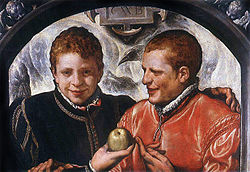
Crispin van den Broeck
Encyclopedia
Crispin van den Broeck was a Flemish painter. He was born in Mechelen
. He came from a family of artists, was probably trained by his father, and was the brother of Willem van den Broeck and Hendrick van den Broeck
. He worked as a painter, draftsman and engraver. He was enlisted as a master in the Guild of St. Luke of Antwerp in 1555–6, where he became a citizen in 1559.
In Antwerp he was a collaborator of Frans Floris
with whom he remained until the master’s death in 1570. According to Karel van Mander, Crispin van den Broeck and Frans Pourbus the elder completed an altarpiece for the Grand-Prior of Spain
left incomplete at the time of Floris’s death. Van Mander also claimed that Crispin van den Broek was 'a good inventor... clever at large nudes and just as good an architect'. Crispin van den Broek died in Antwerp sometime between 1589 and 6 February 1591.
 Van den Broeck's painting Two Young Men has been interpreted as depicting a sexual relationship through its symbolism; this is deemed "unlikely" by the Fitzwilliam Museum
Van den Broeck's painting Two Young Men has been interpreted as depicting a sexual relationship through its symbolism; this is deemed "unlikely" by the Fitzwilliam Museum
, which states that the two young men are more likely brothers, and that death, rather than sex, is the subject of the painting's symbolic allusions.
Mechelen
Mechelen Footnote: Mechelen became known in English as 'Mechlin' from which the adjective 'Mechlinian' is derived...
. He came from a family of artists, was probably trained by his father, and was the brother of Willem van den Broeck and Hendrick van den Broeck
Hendrick van den Broeck
Hendrick van den Broeck, or Arrigo Fiammingo , was a Flemish painter of the late-Renaissance or Mannerist period, active mainly in Italy.-Biography:...
. He worked as a painter, draftsman and engraver. He was enlisted as a master in the Guild of St. Luke of Antwerp in 1555–6, where he became a citizen in 1559.
In Antwerp he was a collaborator of Frans Floris
Frans Floris
Frans Floris, or more correctly Frans de Vriendt, called Floris was a Flemish painter. He was a member of a large family trained to the study of art in Flanders.-Biography:...
with whom he remained until the master’s death in 1570. According to Karel van Mander, Crispin van den Broeck and Frans Pourbus the elder completed an altarpiece for the Grand-Prior of Spain
Spain
Spain , officially the Kingdom of Spain languages]] under the European Charter for Regional or Minority Languages. In each of these, Spain's official name is as follows:;;;;;;), is a country and member state of the European Union located in southwestern Europe on the Iberian Peninsula...
left incomplete at the time of Floris’s death. Van Mander also claimed that Crispin van den Broek was 'a good inventor... clever at large nudes and just as good an architect'. Crispin van den Broek died in Antwerp sometime between 1589 and 6 February 1591.
Themes

Fitzwilliam Museum
The Fitzwilliam Museum is the art and antiquities museum of the University of Cambridge, located on Trumpington Street opposite Fitzwilliam Street in central Cambridge, England. It receives around 300,000 visitors annually. Admission is free....
, which states that the two young men are more likely brothers, and that death, rather than sex, is the subject of the painting's symbolic allusions.

